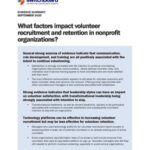There is plenty of evidence demonstrating that volunteering generates benefits for individuals and society at large. However, the role of technology used in recruiting, managing, and retaining volunteers in nonprofits is underexplored in East Asia. Drawing from in‐depth interviews with representatives of eight nonprofits, we examine how technology reconfigured volunteer management in nonprofits, identify its limitations and shortcomings, and discuss strategies in which technology can be utilized to enhance the effectiveness of volunteer management. We found, through this study, that the use of technology reconfigured key aspects of volunteer management: improving recruitment by enlarging and diversifying the volunteer pool; enhancing precision and speed of volunteer matching; improving nonprofits’ ability to recruit professionals; and reducing overall administrative burden of volunteer management within these nonprofits. However, challenges in volunteer management resulting from technology uptake were also observed, including resistance among frontline staff to adopt technology, and volunteer accountability and quality assurance. Specifically, it was found through this study that the extent to which nonprofits are able to effectively utilize technology in volunteer management is contingent on how well volunteer managers are able to actualize the notion of capacity optimization, create a friendly volunteer environment, and build rapport with volunteers. Implications for enhancing organizational capacity in volunteer management vis‐à‐vis the role of technology in the third sector are further discussed.
The management of volunteers – What can human resources do? A review and research agenda
There is an increasing interest from scholars and practitioners in understanding how non-profit organizations can design and implement human resources (HR) practices to enhance desirable volunteer attitudes and behaviors. This paper presents a comprehensive overview of existing studies on the relationship between HR practices and volunteering outcomes. We use the ability-motivation-opportunity model as a guiding…

